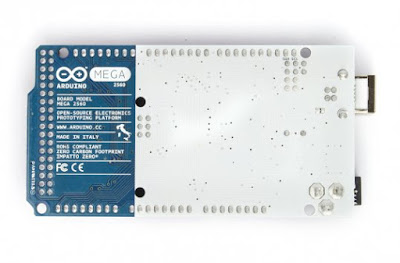It's almost like Christmas when you get a parcel in the post, and there is no better feeling to a nerd than knowing that in that little paper padded bag that fell though the hole in your door is your brand new Arduino Mega 2560 all the way from China, yes I know I got a clone again!
With out further ado gets have a look and see what it has!
*Lets get started*
Just like the other two up-close and personal with the Nano and Uno I will be circling some of the parts and numbering them to which you will find the corresponding explanation.I will only show and annotated version of the clone but I shall put up photos of the originals too.
*The Clone Top Side*
- Full size USB socket
- USB to serial controller CH???
- Oscillator
- "Normal" digital pins, 13 is linked to the on-board LED
- Serial TX + RX (serial 0, 1 of 4)
- Serial TX + RX (serial 3, 4 of 4)
- Serial TX + RX (serial 2, 3 of 4)
- Serial TX + RX (serial 1, 2 of 4)
- I2C (Two wire communication)
- Massive array of digital pins, 22 - 53!
- Analog pins A0 - A15
- Voltage from the External power socket (See point 19)
- Ground pins
- 5v+ pin
- 3.3v+ pin
- Another 5v+ pin
- Power on LED
- LED that is linked to Digital pin 13
- External power in (rating 7 -12 volts)
- LED linked to Serial 0 (Seen number 5)
- Atmel Atmega 2560 chip
- In Circuit Serial Programming (ICSP)
- Reset button
*The Clone Bottom side*
Bugger all! There no components on the bottom side like the Arduino Nano. All there has to been seen are the copper tracks.
*Genuine Arduino Mega 2560*
I did not annotate the differences between then as there is so little different between then there was no point.
Parts of interest; the USB to Serial chip is different and so are a few of the power biased components, other than that its the same.
It goes with out saying that the cheap clone I have feels of a lesser quality than the originals and I did have to sort out one dry joint where the solder was not covering the pin as well as it could have been.
Also the silk screening on the originals looks awesome and its clear to read, that can't be said of the clone!






No comments:
Post a Comment